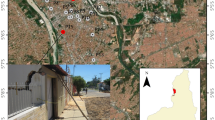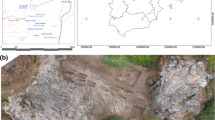Abstract
Evaporitic materials have been studied by means of ground penetrating radar (GPR) in order to evaluate the collapse hazard. The obtained 200 MHz GPR profiles show a low signal-noise ratio over the first 3 m depth, where well-defined and continuous reflectors can be observed. Between 3 and 4.5 m depth, the signal to noise ratio decreases due to attenuation of the electromagnetic (EM) waves. As a result, reflectors located deeper than 3 m become more discontinuous and poorly defined. GPR profiles show trails of continuous and subhorizontal reflectors, with a slightly undulated and irregular geometry. Although some of these reflectors laterally vanish or seem to disappear, sudden interruptions or hyperbolic reflections that could be originated by the occurrence of cavities have not been detected. These reflectors have been interpreted as corresponding to several evaporitic layers (gypsum) that constitute the main lithology in the area. Clear interruptions of reflectors have only been observed in some GPR profiles, and they could be attributed to small (1–2 m long) subvertical faults, with only a few centimetres offset. These faults may be generated by the accommodation of the evaporitic layers to local collapses affecting deeper materials.







Similar content being viewed by others
References
Annan AP (1999) Practical processing of GPR data. Sensors and Software, Ontario
Atekwana EA, Sauck WA, Werkema DD (2000) Investigations of geoelectrical signatures at a hydrocarbon contaminated site. J Appl Geophys 44:167–180
Basson U, Ben-Avraham Z, Garfunkel Z, Lyakhovsky V (2002) Development of recent faulting in the southern Dead Sea Rift according to GPR imaging. EGS Stephan Mueller Spec Publ Ser 2:1–23
Batayneh AT, Abueladas AA, Moumani KA (2002) Use of ground-penetrating radar for assessment of potential sinkhole conditions: an example from Ghor el Haditha area, Jordan. Environ Geol 41:977–983
Benito G, Pérez del Campo P, Gutiérrez-Elorza M, Sancho C (1995) Natural and human-induced sinkholes in gypsum terrain and associated environmental problems in NE Spain. Environ Geol 25:156–164
Cagnoli B, Ulrych TJ (2001) Ground penetrating radar images of unexposed climbing dune-forms in the Ubehebe hydrovolcanic field (Death Valley, California). J Volcanol Geoth Res 109:279–298
Claerbout JF (2004) Earth soundings analysis: processing versus inversion. Blackwell, Cambridge
Daniels DJ (1996) Surface-penetrating radar. The Institution of Electrical Engineers, London, UK
Davis JL, Annan AP (1989) Ground-penetrating radar for high-resolution mapping of soil and rock stratigraphy. Geophys Prospect 37:531–551
Doolittle JA, Jenkinson B, Hopkins D, Ulmer M, Tuttle W (2006) Hydropedological investigations with ground-penetrating radar (GPR): estimating water-table depths and local ground-water flow pattern in areas of coarse-textured soils. Geoderma 131:317–329
Godoy A, Ramírez JI, Olivé A, Moissenet E, Aznar JM, Aragonés E, Aguilar MJ, Ramírez del Pozo J, Leal MC, Jerez Mir L, Adrver R, Goy A, Comas MJ, Alberdi MT, Giner J, Gutiérrez Elorza M, Portero JM, Gabaldón V (1983) Mapa Geológico de España 1: 50.000, hoja no 567 (Teruel). IGME
Gómez-Ortiz D, Martín-Velázquez S, Martín-Crespo T, Márquez A, Lillo J, López I, Carreño F (2006) Characterization of volcanic materials using ground penetrating radar: a case study at Teide volcano (Canary Islands, Spain). J Appl Geophys 59:63–78
Gutiérrez-Santolalla F, Gutiérrez-Elorza M, Marín C, Maldonado C, Younger PL (2005) Subsidence hazard avoidance based on geomorphological mapping in the Ebro River valley mantled evaporite karst terrain (NE Spain). Environ Geol 48:370–383
Holub P, Dumitrescu T (1994) Détection des cavités à l’aide de mesures électriques et du géoradar dans une galerie d’amenée d’eau. J Appl Geophys 31:185–195
Miyamoto H, Haruyama J, Rokugawa S, Onishi K, Toshioka T, Koshinuma J (2003) Acquisition of ground penetrating radar data to detect lava tubes: preliminary results on the Komoriana cave at Ruji volcano in Japan. B Eng Geol Environ 62:281–288
Neal A (2004) Ground-penetrating radar and its use in sedimentology: principles, problems and progress. Earth Sci Rev 66:261–330
Porsani JL, Sauck WA, Júnior AOS (2006) GPR for mapping fractures and as a guide for the extraction of ornamental granite from a quarry: a case study from southern Brazil. J Appl Geophys 58:177–187
RADAN for Windows (1997) GPR processing software. Geophysical Survey System
Radzevicius SJ, Guy ED, Daniels JJ (2000) Pitfalls in GPR data interpretarion: differentiating stratigraphy and buried objects from periodic antenna and target effects. Geophys Res Lett 27:3393–3396
Ranalli D, Scozzafava M, Tallini M (2004) Ground penetrating radar investigations for the restoration of historic buildings: the case study of the Collemaggio Basilica (L’Aquila, Italy). J Cult Herit 5:91–99
Reynolds JM (1997) An introduction to applied and environmental geophysics. Wiley, New York
Russell JK, Stasiuk MV (1997) Characterization of volcanic deposits with ground-penetrating radar. B Volcanol 58:515–527
Soupios PM, Papadopoulos I, Kouli M, Georgaki I, Vallianatos F, Kokkinou E (2006) Investigation of waste disposal areas using electrical methods: a case study from Chania, Crete, Greece. Environ Geol (in press)
Splajt T, Ferrier G, Frostick LE (2003) Application of ground penetrating radar in mapping and monitoring landfill sites. Environ Geol 44:963–967
Telford WM, Geldart LP, Sheriff RE (1990) Applied Geophysics. Cambridge University Press, London, 770 p
Tsokas G, Soupios P, Tsourlos P, Vargemezis G, Savvaidis A, Paliadeli-Saatsoglou C, Drougou S (1999) Geophysical investigations in the area between Eukleia’s temple and the theater in ancient Aegae (Verghina) using various methods. Physics in Culture. Aristotle University Publication, Thessaloniki
Yilmaz O (1987) Seismic data processing. Society of exploration geophysics, Tulsa
Zhou W, Beck BF, Adams AL (2002) Effective electrode array in mapping karst hazards in electrical resistivity tomography. Environ Geol 42:922–928
Acknowledgments
The authors would like to thank Henrique Lorenzo and Javier Lillo for their critical revision of the original manuscript. We wish to thank Antonio Mas Atienza and David Olmedilla, for their technical support during the data acquisition. The useful comments from an anonymous reviewer also helped to improve the manuscript.
Author information
Authors and Affiliations
Corresponding author
Rights and permissions
About this article
Cite this article
Martín-Crespo, T., Gómez-Ortiz, D. Collapse hazard assessment in evaporitic materials from ground penetrating radar: a case study. Environ Geol 53, 57–66 (2007). https://doi.org/10.1007/s00254-006-0618-1
Received:
Accepted:
Published:
Issue Date:
DOI: https://doi.org/10.1007/s00254-006-0618-1




